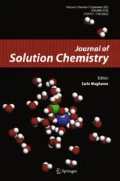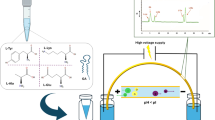Abstract
Magnesium gluconate is a classical pharmaceutical compound used as a source of magnesium for the prevention and treatment of hypomagnesemia. To the best of our knowledge, a robust and reliable liquid chromatography tandem mass spectrometry technique has not yet been reported for the qualitative and quantitative analysis of magnesium gluconate. This study describes the method development for the LC–ESI–MS/MS analysis of magnesium gluconate using three different reversed-phase HPLC conditions (Method I–III) with comprehensive fragmentation pattern and the structural characterization by NMR spectroscopy. The LC–MS and NMR data were found in accordance with the structure of magnesium gluconate. When magnesium gluconate was dissolved in the acetonitrile and water–methanol solutions, it exists in situ in three different forms: magnesium gluconate itself, gluconic acid, and magnesium gluconate chelate with gluconic acid by a coordinate covalent bond. Method I exhibited pseudo-molecular ion peaks with more magnesium gluconate chelates with gluconic acid, while method II showed an adduct of magnesium gluconate with the solvent along with the molecular ion peak. There was no pseudo-molecular ion peaks found in method III. Thus, method III was found to be the more accurate, robust and reliable LC–MS method for the qualitative and quantitative analysis, structural characterization, and could also be suitable for the pharmacokinetic study of magnesium gluconate. The detailed fragmentation analysis might be useful for the structural characterization of unknown divalent organometallics.








Similar content being viewed by others
References
Jirásko, R., Holčapek, M.: Structural analysis of organometallic compounds with soft ionization mass spectrometry. Mass Spectrom. Rev. 30, 1013–1036 (2011)
Haneef, J., Shaharyar, M., Husain, A., Rashid, M., Mishra, R., Parveen, S., Ahmed, N., Pal, M., Kumar, D.: Application of LC–MS/MS for quantitative analysis of glucocorticoids and stimulants in biological. J. Pharm. Anal. 3, 341–348 (2013)
Patel, K.N., Patel, J.K., Patel, M.P., Rajput, G.C., Patel, H.A.: Introduction to hyphenated techniques and their applications in pharmacy. Pharm. Method. 1, 2–13 (2010)
Pitt, J.J.: Principles and applications of liquid chromatography-mass spectrometry in clinical biochemistry. Clin. Biochem. Rev. 30, 19–34 (2009)
Hoja, H., Marquet, P., Verneuil, B., Lotfi, H., Pénicaut, B., Lachâtre, G.: Applications of liquid chromatography-mass spectrometry in analytical toxicology: a review. J. Anal. Toxicol. 21, 116–126 (1997)
Heaton, F.W.: Role of magnesium in enzyme systems in metal ions in biological systems. In: Sigel, H., Sigel, A. (eds.) Compendium on Magnesium and its Role in Biology, Nutrition and Physiology, 26th edn. Marcel Dekker Inc., New York (1990)
Garfinkel, L., Garfinkel, D.: Magnesium regulation of the glycolytic pathway and the enzymes involved. Magnesium 4, 60–72 (1985)
Fleming, T.E., Mansmann Jr., H.C.: Methods and compositions for the prevention and treatment of diabetes mellitus, US Patent 5871769 (1999)
Fleming, T.E., Mansmann Jr., H.C.: Methods and compositions for the prevention and treatment of immunological disorders, inflammatory diseases and infections. US Patent 5939394 (1999)
Weglicki, W.B.: Intravenous magnesium gluconate for treatment of conditions caused by excessive oxidative stress due to free radical distribution. US Patent 6100297 (2000)
Martin, R.W., Martin Jr., J.N., Pryor, J.A., Gaddy, D.K., Wiser, W.L., Morrison, J.C.: Comparison of oral ritodrine and magnesium gluconate for ambulatory tocolysis. Am. J. Obstet. Gynecol. 158, 1440–1445 (1988)
Turner, R.J., Dasilva, K.W., O’Connor, C., van den Heuvel, C., Vink, R.: Magnesium gluconate offers no more protection than magnesium sulfate following diffuse traumatic brain injury in rats. J. Am. Coll. Nutr. 23, 541S–544S (2004)
Lee, K.H., Chung, S.H., Song, J.H., Yoon, J.S., Lee, J., Jung, M.J., Kim, J.H.: Cosmetic compositions for skin-tightening and method of skin-tightening using the same. US Patent 8580741 B2 (2013)
Coudray, C., Rambeau, M., Feillet-Coudray, C., Gueux, E., Tressol, J.C., Mazur, A., Rayssiguier, Y.: Study of magnesium bioavailability from ten organic and inorganic Mg salts in Mg-depleted rats using a stable isotope approach. Magnes. Res. 18, 215–223 (2005)
Gröber, U., Schmidt, J., Kisters, K.: Magnesium in prevention and therapy. Nutrients 7, 8199–8226 (2015)
Swaminathan, R.: Magnesium metabolism and its disorders. Clin. Biochem. Rev. 24, 47–66 (2003)
Guerrera, M.P., Volpe, S.L., Mao, J.J.: Therapeutic uses of magnesium. Am. Fam. Physician 80, 157–162 (2009)
Huang, X., Barnard, J., Spitznagel, T.M., Krishnamurthy, R.: Protein covalent dimer formation induced by reversed-phase HPLC conditions. J. Pharm. Sci. 102, 842–851 (2013)
Miertus, S., Bertocchi, C., Krempaska, R., Paoletti, S.: Conformational analysis of segments of oxidized cellulose. Part I: molecular modelling of glucuronic acid dimers considering the effect of counter-ions and a polar environment. Int. J. Biol. Macromol. 17, 183–188 (1995)
Burgess, J.: Magnesium absorption and assimilation in The AFIB Report. In: Larsen, H.R. (ed) http://www.afibbers.org/resources/magnesiumabsorption.pdf. Accessed 26 July 2016
Schug, K., McNair, H.M.: Adduct formation in electrospray ionization. Part 1: common acidic pharmaceuticals. J. Sep. Sci. 25, 759–766 (2002)
Mortier, K.A., Zhang, G.F., van Peteghem, C.H., Lambert, W.E.: Adduct formation in quantitative bioanalysis: effect of ionization conditions on paclitaxel. J. Am. Soc. Mass Spectrom. 15, 585–592 (2004)
Nikolic, V.D., Illic, D.P., Nikolic, L.B., Stanojevic, L.P., Cakic, M.D., Tacic, A.D., Ilic-Stojanovic, S.S.: The synthesis and characterization of iron (II) gluconate. Adv. Technol. 3, 16–24 (2014)
Bailey, G.D., Carper, W.R.: 13C NMR relaxation studies of gluconate and magnesium–gluconate interactions. J. Inorg. Biochem. 52, 99–108 (1993)
Acknowledgements
The authors are grateful to GVK Biosciences Pvt. Ltd., Hyderabad, India for their assistance and support during this work.
Author information
Authors and Affiliations
Corresponding author
Rights and permissions
About this article
Cite this article
Trivedi, M.K., Panda, P., Sethi, K.K. et al. Liquid Chromatography Tandem Mass Spectrometry and Nuclear Magnetic Resonance Spectroscopy of Magnesium (II) Gluconate Solution. J Solution Chem 46, 896–907 (2017). https://doi.org/10.1007/s10953-017-0613-z
Received:
Accepted:
Published:
Issue Date:
DOI: https://doi.org/10.1007/s10953-017-0613-z




